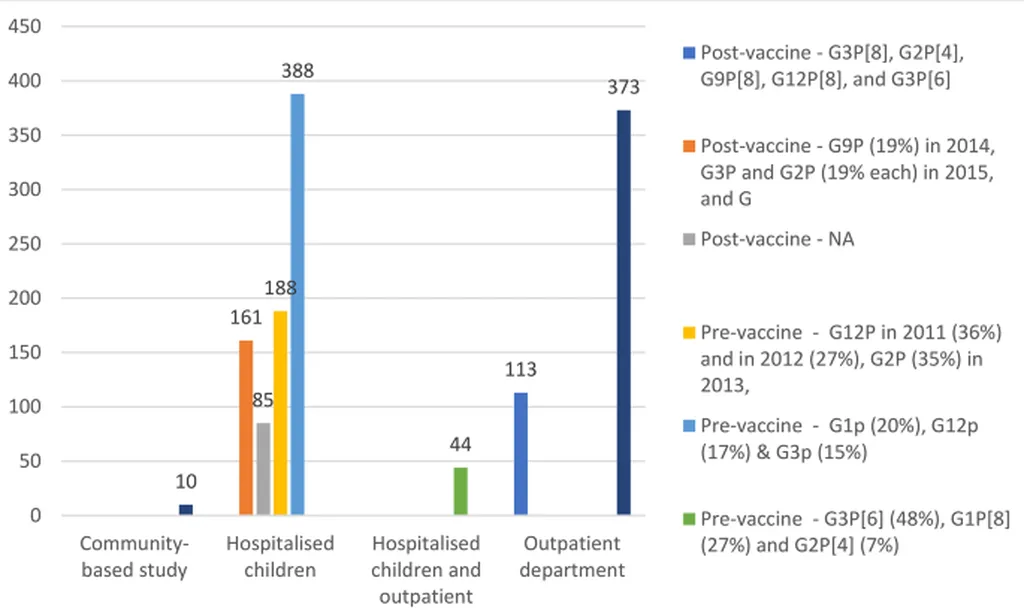In the heart of Ethiopia, a silent battle rages on against a microscopic foe: rotavirus A, a leading cause of severe gastroenteritis in children. Despite the introduction of vaccines, the virus’s high mutation and reassortment rates pose a significant challenge to public health efforts. A recent study, led by Yisehak Tsegaye Redda from the Biotechnology Research Center at Addis Ababa University, sheds light on the genetic diversity and antigenic profile of rotavirus A strains in central Ethiopia, with implications for the efficacy of the widely used Rotarix® vaccine.
The study, published in *Frontiers in Microbiology* (which translates to “Frontiers in Microbiology” in English), collected stool samples from children under five with diarrhea in Debre Berhan and Addis Ababa between April 2022 and December 2023. The researchers detected rotavirus A in 12.14% of the samples, with a diverse range of genotypes. “The dominance of the G9P[4] genotype, together with substantial amino acid substitutions in the current circulating RVA strains, is a cause for concern,” Redda noted.
The findings revealed that the most common genotype was G9 (50%), followed by G12 (10.2%), G2 (7.1%), G1 (3.6%), and G3 (3.6%), with 25% remaining untyped. The P[4] genotype was the most frequent (28.6%), followed by P[6] (21.4%) and P[8] (17.9%), with 32.1% untyped. The most frequent G/P combinations were G9P[4] (35%), G12P[6] (13%), and G9P[8] (9%).
Comparing the circulating strains to the Rotarix® vaccine strain, the researchers found significant amino acid substitutions within key antigenic regions. “These substitutions may compromise vaccine performance,” Redda explained. The G2, G3, G9, and G12 strains showed 18, 12, 13, and 17 amino acid substitutions, respectively, within the 29-residue VP7 epitopes. The P[8], P[4], and P[6] strains exhibited 4, 9, and 18 substitutions, respectively, within the 28 VP4 neutralizing epitope residues.
Phylogenetic analysis revealed that the current identified virus mainly clusters with strains previously reported from Ethiopia, indicating a shared evolutionary origin. This genetic diversity and the substantial amino acid substitutions raise concerns about the efficacy of the Rotarix® vaccine in the region.
The study underscores the need for continuous molecular surveillance and the potential incorporation of broader genotype coverage in future vaccine design. “Our findings highlight the importance of evaluating vaccine efficacy and maintaining molecular surveillance to stay ahead of the virus’s evolutionary game,” Redda stated.
This research not only contributes to our understanding of rotavirus A diversity in central Ethiopia but also has broader implications for global health. As the world continues to combat vaccine-preventable diseases, studies like this one are crucial for informing public health strategies and ensuring that vaccines remain effective against evolving pathogens.
In the energy sector, the implications of such research might seem distant, but the principles of adaptation and evolution are universal. Just as viruses mutate and adapt, so too must our approaches to energy production and consumption. The fight against rotavirus A in Ethiopia serves as a reminder of the constant need for innovation and vigilance in all sectors, including energy. As we strive to develop more efficient and sustainable energy solutions, we must remain adaptable and responsive to the ever-changing landscape of global health and environmental challenges.
In the words of Yisehak Tsegaye Redda, “The battle against rotavirus A is far from over, but with continued research and vigilance, we can stay one step ahead.” This sentiment resonates not only in the field of public health but also in the broader context of global development and innovation.

